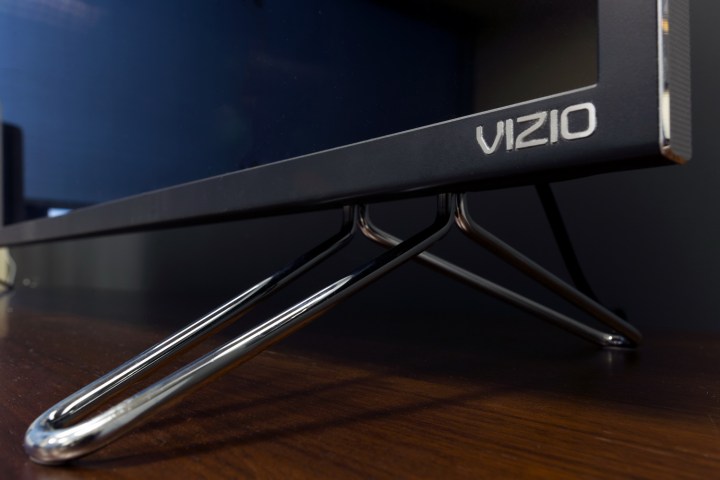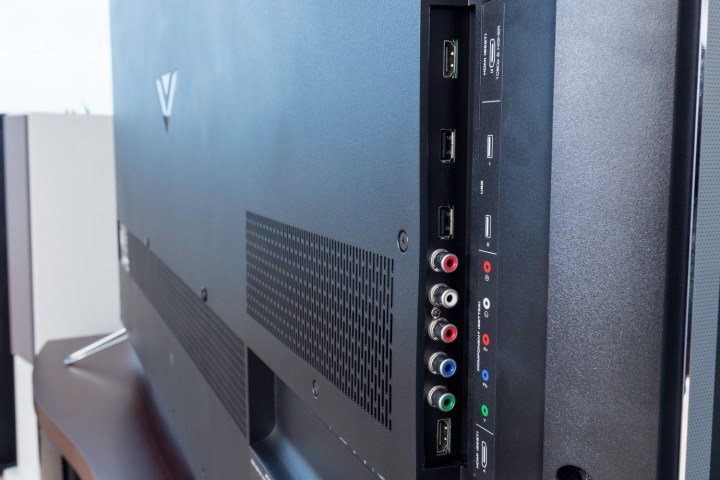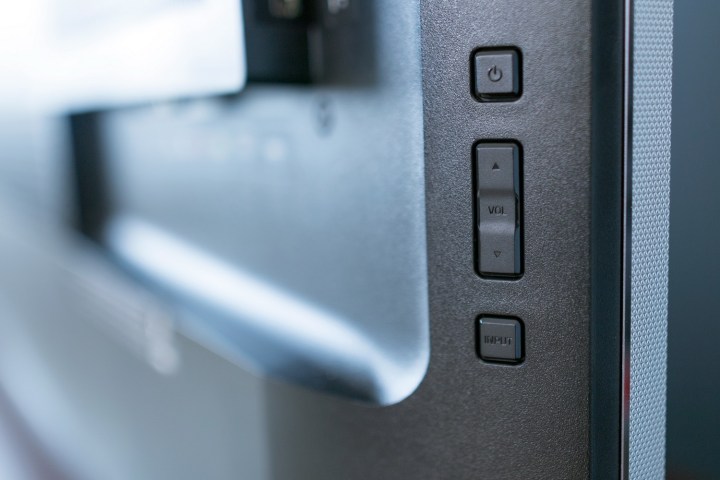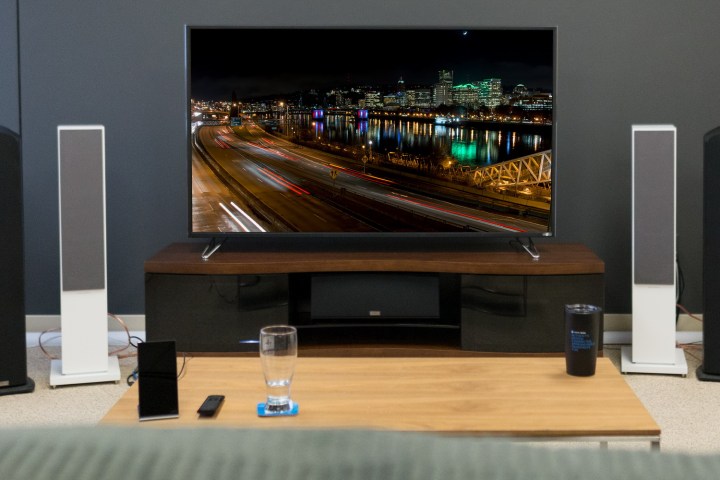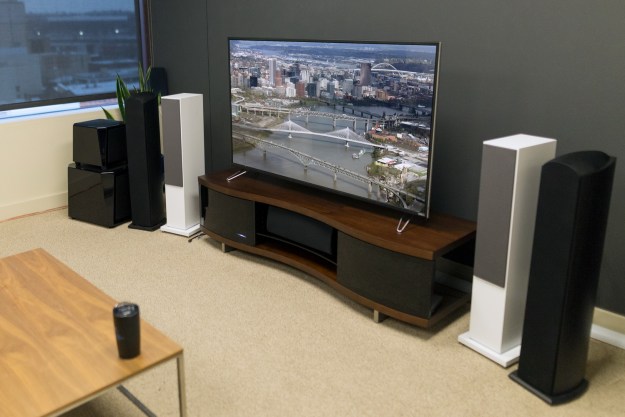
“Vizio’s M65-D0 offers some of the best dollar-for-dollar picture quality you can find.”
- Excellent contrast, rich black levels
- Brilliant and fairly accurate colors
- Sharp 4K picture
- Support for both HDR10 and Dolby Vision HDR
- Free Android tablet included
- Tablet UI quirks can be a headache
- Only one HDMI input with HDR support
- No TV tuner
Set at the sweet spot that is Vizio’s upper-middle tier of televisions, the M-series offers a bountiful proposition of TV goodness that could be seen as a microcosm of the brand’s overall philosophy. Boasting 4K resolution, support for both major HDR formats, full-array local dimming, and even a free tablet thrown in to pilot Vizio’s SmartCast user interface, the M-series’ low price and packed feature set read like the TV deal of the decade.
When the rubber hits the road, though, this value-packed TV does show some weak spots, most of which stem from its tablet-based operating system. Built off of Google’s Chromecast tech, the tablet’s dependency on Wi-Fi and Bluetooth pairing makes TV operation less than convenient in day-to-day use.
Quirks aside, if a gorgeous picture trumps a few minor annoyances in your book, the M-series is one of best values on the market.
Out of the box
We evaluated the M-series 65-inch model, the M65-D0, which offers some notable performance boosts over its smaller brethren, outlined below. The screen real estate is worth it, but hauling it home will be no easy task thanks to packaging of mammoth proportions and a whopping weight of 73 pounds total (57 pounds for the TV alone), making it one of the heaviest TVs we’ve reviewed.
Stripped of its cardboard carton, the TV is a simple black rectangle with a half-inch bezel that’s just slim enough to provide a modern aesthetic. Silver-beaded side panels offers some extra style points, though the legs shaped like oversized paperclips don’t do the TV any favors there.
Sequestered at the very bottom of the package is a box of accessories, including an HDMI cable, a bare-bones remote and batteries, screws for attaching the stands, and an AC power cable. But the real prize to unwrap here is the little black box that harbors an Android tablet, an attractive magnetic base that serves as its charging station, and a removable charging cable.
Features and design
Note: During our evaluation, an issue often occurred in which the TV would prominently display green horizontal bars when we loaded a 4K Ultra HD Blu-ray. Vizio has assured us this is an isolated incident related to software (not hardware), so we did not weigh the issue in our review. We will update this post once we have more information.
In addition to its hefty weight, the M65-D0’s full-array backlighting makes this baby a bit thicker than your average set, stretching back over 2.5 inches. That’s actually a good sign for picture enthusiasts, and while it may put off those looking for a razor-thin profile, the majority of high-performance TVs are on the wide side, even at the premium tier — unless you step up to OLED, that is.
At the back panel is an ample collection of inputs, especially for a mid-level set, but what you won’t find, try as you might, is a traditional coaxial cable input. That’s because the M-series has no TV tuner built-in, meaning it’s not so much a TV as it is a really big LCD “display.” You can buy an outboard tuner for around $40-100, but cord-cutters who rely on a digital antenna for local programming will definitely want to factor this in.
The picture looks fantastic in virtually any lighting.
Ports that did make the cut include dual USB inputs, a hybrid composite/component input, an Ethernet jack, both an analog and digital optical audio output, and five HDMI inputs, including one with ARC. Only one of the inputs (HDMI 1) supports both 4K resolution and
Speaking of
Our 65-inch review model is listed as a 120Hz panel (with 240Hz “effective refresh rate” via motion smoothing), and we found its motion resolution to be quite good. The 55-inch and 50-inch models, by contrast, offer a basic 60Hz panel and may not yield such solid results. Going with the 65-inch version also scores you 64 active zones for the full-array backlighting system, which can be individually controlled for better contrast levels, while the 60-inch model offers half that number. As a general rule, more zones results in better contrast, and therefore, better overall picture quality.
Vizio SmartCast: To live and die by the tablet
For its E-series, M-series, and P-series TVs, Vizio replaced its Smart TV interface with Google Cast technology (based on the same tech inside the Chromecast streaming device), and in doing so, the company has relegated virtually all of the TV’s controls to its SmartCast app. The included, stripped-down remote can still manage basic functions like volume, power, and input switching, but the rest of the M65-D0’s controls – for picture settings, audio settings, network … everything — rest within the included
It’s a pretty sleek setup at a glance; the tablet pairs to the TV by simply holding it to the corner (thanks to NFC) and, from there, connects both devices to your local network. The tablet comes loaded with a sparse collection of streaming apps, including YouTube, Vudu, and Netflix, but Google Play allows for an incredible array of options. Typing in passwords and making adjustments to the picture, audio, and other settings on the tablet’s touchscreen via the SmartCast app is also highly convenient … when it works.
However, with more connected devices comes more problems. While connecting the tablet to the TV initially was brilliantly simple, bringing both devices online for the initial setup put us in update hell. Not only did the TV need multiple updates (which is pretty standard), the tablet did too, doubling the load. That translated to 15-20 minutes of updates before we could watch a single pixel fire, with more to come later on, including several tablet updates for Google Play services which tells you curtly “this device won’t run without it.”
Picture settings
- Picture Mode: Calibrated
- Backlight: 65
- Brightness: 48
- Contrast: 47
- Color: 50
- Sharpness: 20
- Tint: -3
- Color Temperature: Normal
- Black Detail: Off
- Active LED Zones: On
- Reduce Judder: 2
- Reduce Motion Blur: 1
- Clear Action: off
- Reduce Signal Noise: Low
- Reduce Block Noise: Low
- Game Low latency: off (on for gaming)
- Film Mode: Auto
- Color Space: auto
- Gamma: 2.1
What’s more, when we attempted to connect the two devices to a different local network, they refused to pair, putting us in a feedback loop of trying to connect each to the other. We finally found a solution by linking the tablet to the TV’s own internal Wi-Fi signal, then going into the SmartCast menu and changing the TV’s Wireless Access Point. We were then able to direct the TV to our new Wi-Fi network, which somehow allowed the tablet to “follow the display” to the network, and the two reconnected. Still, it’s a frustrating experience when the devices won’t auto-pair, and it happened in two different locations.
Even when things worked by design, we’re just not crazy about the tablet solution. For one thing, a random tablet update shouldn’t pause TV time. More practically, if you don’t have a power port nearby for the tablet’s charging dock, you’re likely to find the tablet constantly running low on battery after forgetting to dock it. Occasional casting issues (with which any Chromecast user will likely identify), volume discrepancies between streaming apps, and a lack of any global setting for picture adjustments all added to the inconvenience, making us wish longingly for Vizio’s old-school Smart TV remote.
Performance
The good news is, if you can get over the quirks of the tablet-based control scheme, the M65-D0 offers some of the best picture quality for the money you can find on the market. This TV looks fantastic when you turn it on, in virtually any lighting. The picture displays rich and relatively accurate colors, deep black levels that make for brilliant contrast between light and dark scenes, and impressive overall uniformity, allowing you to get lost in a gleaming skyscape or an inky black sprawl of stars.
Rendering of 4K content is also excellent, revealing crystal clear images in newer TV titles like Netflix’s Luke Cage or House of Cards that allow your eyes to capture every minute detail. YouTube’s growing collection of
When it comes to
Moving to
Marco Polo’s long and smoldering episodes are absolutely captivating in
In that scene in particular, we noticed some judder as the camera pans from side to side to show the full army, though it wasn’t distracting enough to give us pause. That scene also offered the most obvious example of the screen’s propensity to dull at the TV’s left and right edges — in The Martian this was reflected in a slight tinge of green against the rusty Martian landscape. Still, the M65-D0’s overall screen uniformity is impressive for an LCD display of this size, as is the off-axis viewing angle, which outdoes Samsung’s 55-inch KU7000 TV in visual comparisons.
We do need to quickly address the sound of this display, which is pretty poor even for a flat panel, offering a tinny resonance that’s short on detail. We personally never recommend going without some sort of audio supplement with any TV anyway, so it really didn’t surprise us, but it’s worth noting for those who rely on TV audio alone.
Our Take
While Vizio’s new SmartCast tablet system gave us more headaches than its cool factor made up for, the M65-D0 offers perhaps the most impressive picture quality in its price range, which makes it well worth considering — especially for videophiles on a tight budget.
How long will it last?
That is the million-dollar question for the M65-D0 at this point. While we reviewed this TV with disregard to the odd green-bar issue we encountered, we have only Vizio’s word that this is an isolated incident. We have no reason to believe this problem is widespread beyond our display, but we also haven’t heard back about any firmware update or other solution. As always, savvy buyers will want to make sure their warranty information is at the ready just in case.
What are the alternatives?
Those who care more about usability than videophile performance may want to look at Samsung’s KU7000 series, which doesn’t offer contrast or black levels nearly as impressive as the M65-D0, but has a much more user-friendly interface powered by an extremely convenient (and stylish) remote.
Should you buy it?
If you’re all about picture performance, then yes. Those looking for a TV that far outperforms its price class, and who don’t mind some odd quirks in the daily operation, will reap serious value in their M-series purchase. However, if you’re a bit of a TV novice, you may want to try out the tablet system for yourself before you buy.
Editors' Recommendations
- Best Walmart TV deals: 43-inch 4K TV for $195 and more
- Sony debuts the Bravia 9, its brightest 4K TV ever, alongside new 2024 models
- Best 8K TV deals: Samsung and LG starting at $2,500
- Best OLED TV deals: Save on LG C3, Samsung S90C, and more
- Samsung’s new 98-inch DU9000 4K TV is just $4,000. Can it beat TCL and Hisense?

